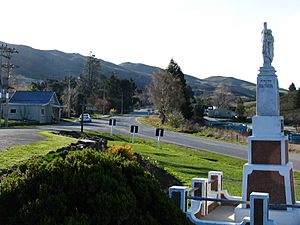Hyde, New Zealand facts for kids
Hyde is a locality in Otago, New Zealand, located in the Strath-Taieri. It is close to the northern end of the Rock and Pillar Range on State Highway 87 between Middlemarch and Ranfurly. Hyde is best known as the site of the Hyde railway disaster of 4 June 1943, in which 21 people were killed when an express train on the Otago Central Railway derailed at high speed in a cutting near the town. At the time, it was the worst railway accident in New Zealand's history; it has only been passed by the Tangiwai disaster of 24 December 1953, which claimed the lives of 151 people. The site of the Hyde disaster can now be walked as part of the Otago Central Rail Trail and a monument, a 2.5 m high cairn, stands as a memorial to the victims.
Economy
The economy is principally based around servicing the surrounding farms, though since the development of the Otago Central Rail Trail tourism has gained more importance for the community with many farming families having taken the opportunity to diversify their farming operations by providing accommodation for users of the rail trail. The Otago Central Hotel has been restored and today offers accommodation place and a cafe. The old Hyde School has been turned it into a convention centre. The old Hyde Railway Station is also being redeveloped. Just north of Hyde a "white ball" clay deposit is mined to provide high-quality pottery clay. To the southeast of town a quarry produces schist rock used in landscaping and house building.
Education
Hyde's first schools were short-lived private institutions, but none lasted long. Among them was a night school conducted by David Syme at the end of 1869 but it only lasted for a few months on account of his leaving for new fields. A day school was started by Kate Gildea with about a dozen pupils, one of whom, Bessie McRae, walking to it from McRae's Ferry. It only lasted a short time until her she left to enter the estate of matrimony. Finally, in 1869, the Protestants placed the United Church at the disposal of the Provincial Education Department for use on week days as a school, and a subsidised teacher, Seymour K. Saunders was sent up. The people built a small residence, and an official public school began in Hyde with 22 pupils. Saunders was succeeded by F. G. Odell.
Eventually the school committee decided that the school needed better accommodation than the small iron church which having no ventilation was unbearably hot in summer, and very cold in winter. The committee were successful in building a new simple one room wooden school in 1879 on a site at 9125 Eton Street (State Highway 87). The school continued to grow, and by 1893 its one room was crowded with 80 pupils, which led to a second classroom being built on the northern side of the building in 1894 at a price of £191.
Although the school never grew beyond these two classrooms, various amenities were added in the twentieth century. In 1956 an ablution block was added, a welcome improvement on the long-drops which had been used up until that time. In addition to schooling, the building has been used for various community activities over the years. The role declined over the years to just four pupils by the time the school was closed at the end of 1999.
The school building was granted Heritage New Zealand historic place category 2 status in 2004.
Infrastructure
Due to insufficient flat ground in the original township when the Otago Central Railway line was built, the Hyde railway station complete with stationmaster's house, engine shed, the line's first locomotive shed and stockyards had to be located 2 kilometres (1.2 mi) to the south where there was sufficient flat land to on and offload wagons. In addition to the railway station there was a flag station called ("Hyde Township") close to the present Otago Central Hotel, at which all trains stopped to provide passengers with direct access to the township itself.
The railway line closed in 1990. The station was once very busy with railway wagons loaded with scheelite, pure white silica sand for glass making, schist rock used by builders, clay which was used to produce fine pottery by pottery works in Christchurch and Auckland.
The only road other than the state highway is named after one of the gold mining settlements first resident's Michael Prendergast, hence Prendergast Road.



